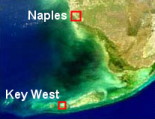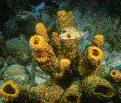|
V RaptureChrist Newsletter
|
||||
Global warming of the oceans is changing the ecosystem. Many species of algae and bacteria increase when the ocean waters get hotter. Oceanographers have compiled more than 5 million ocean temperature readings taken in the Atlantic, Indian and Pacific oceans from 1948 to 1996.  Their study found that ocean temperatures
below 300 meters have risen 1/10 of a degree Fahrenheit since the 1950s;
but closer to the surface, where corals grow, the temperature of sea water
has risen a lot more. Their study found that ocean temperatures
below 300 meters have risen 1/10 of a degree Fahrenheit since the 1950s;
but closer to the surface, where corals grow, the temperature of sea water
has risen a lot more.
Scientists have found that the tropical phenomenom "El Niņo" can cause warming of the waters as far as the Indian Ocean. Julia Cole of the University of Arizona and co-author of a report on coral growth rings, states: "The temperature in the region over the last decade was warmer than during the past two centuries," "There are not many records of actual ocean temperatures, so adding ocean measurements to the pool, that's one more piece of information that makes a strong case that something unusual is going on." The unusual occurrence is a global warming of seawater. When the water in the oceans get unusually warm, coral starts to die. "Many corals die when sea temperature exceeds 31 degrees centigrade (94 degrees Fahrenheit)," said Tim McClanahan of the Wildlife Conservation Society and a member of the research team. "The effects of El Niņo have killed many of the corals in the western Indian Ocean, despite being far from the center of the El Niņo phenomenon. Our study shows that we can expect more warming and coral mortality in the future..." Warmer ocean temperatures cause bleaching
of the coral. This is due to loss of a symbiotic algae that provides
the coral with color and nutrition. The coral can recover if cooler waters
prevent the death of the algae, otherwise we have a destruction of the
coral reef. One of the most important ecosystems on Earth are
the coral reefs which provide habitat for 25 percent of marine species. Another bleaching episode happened in 1998 due to El Niņo, which resulted in an increase of 2 degrees Fahrenheit in the temperatures of the oceans. This caused 15 percent of worldwide coral reefs to be destroyed, said Hodgson. "In order for the reefs to recover, water temperatures must drop," said Bruce Carlson, director of the Waikiki Aquarium in Honolulu, Hawaii, who witnessed the bleaching events in Fiji. |
A mass of slimy putrid black water is advancing down the Florida coast asphyxiating the delicate corals and sponges. The "snotty", "sewage-like" black water is devoid of fish.  The devastated sponges were observed on March
23, 2002 off the coast of Key West by Ken Nedimyer, who collects specimens for the
aquarium trade. "The water was a creepy green at
the surface and by the time I got to the bottom, it was really creepy and
dark," said Nedimyer. He noted that 50 to 75
percent of six species of rope sponge were wiped out. Other marine
animals such as corals and starfish are being decimated too. The devastated sponges were observed on March
23, 2002 off the coast of Key West by Ken Nedimyer, who collects specimens for the
aquarium trade. "The water was a creepy green at
the surface and by the time I got to the bottom, it was really creepy and
dark," said Nedimyer. He noted that 50 to 75
percent of six species of rope sponge were wiped out. Other marine
animals such as corals and starfish are being decimated too.
"There's a real meltdown occurring down
there right now," Nedimyer said. "The sponge die-off is another strong
indicator that the culprit is an explosion of some sort of microscopic
plankton, said Brian Keller, the sanctuary's science coordinator. The "black blob" has moved south against the Florida keys due to the movement of the Gulf Stream and the fact that the keys act as a barrier that impedes the escape of the "blob." Another fact is that, from Naples to the Florida Keys, the larger continental shelf makes for shallower waters, therefore the volume of water in that region is smaller per square mile than on the east coast of Florida. These shallow waters are heated to higher temperatures than deeper waters on the east coast; also the contamination is faster.  These two -- higher temperatures and
contamination with nitrogen are what is needed for the wrong type of algal
bloom to flourish and kill the delicate marine animals whose main mode of
nutrition is by water filtration -- the sponges and corals. These two -- higher temperatures and
contamination with nitrogen are what is needed for the wrong type of algal
bloom to flourish and kill the delicate marine animals whose main mode of
nutrition is by water filtration -- the sponges and corals.
When the sponges and corals are gone, the life of the ocean is gone. No wonder God said: Revelation 16:3 |
|||